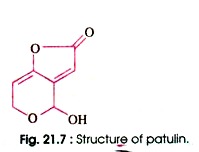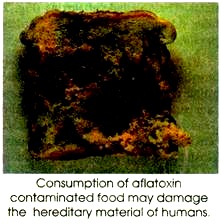ADVERTISEMENTS:
The below mentioned article provides notes on alfatoxins.
Mycotoxins are the toxic substances produced by fungi on food materials. These are ‘secondary metabolites’. Some of these cause very severe effects on animal, plant and microbial systems. These include aflatoxins (Fig. 21.6) ochratoxins, sterigmatocystin, citrinin (Fig. 21.7) patulin, rubratoxin, zearalenone and trichothecens and are produced by the different species of Aspergillus, Penicillium, and Fusarium.
Structure:
ADVERTISEMENTS:
Aflatoxins are highly oxygenated heterocyclic compounds. They contain a coumarin nucleus fused to a bi-furan and in case of aflatoxin B, a pentanone structure which is substituted in aflatoxin G by a six membered lactone is present.
In some animals, aflatoxins B1 and B2 are partially metabolised to give hydroxylated derivatives, which have been called aflatoxins M1 and M2 or milk toxins. Other aflatoxins isolated from the cultures of Aspergillus flavus are aflatoxins B2a, G2a, aflatoxicol, aflatoxins H, aflatoxins P1 and aflatoxins Q1. More than two dozen aflatoxins and their derivatives are now known.
Function:
ADVERTISEMENTS:
During metabolism the fungi not only produce mycotoxins in the substrates but they also cause considerable loss to the food substrates by changing the levels of some of their vital chemical components. Toxigenic strains of A. flavus and A. parasiticus cause significant change during their infestations in the levels of sugar, protein, ascorbic acid and phenols of some fleshy fruits.
There are only three important mycotoxicoses for which there exist reasonable evidences to associate the toxins with human diseases. These are the well known diseases like ergotism, alimentary toxic aluki (ATA) and the liver cancer or Reye’s syndrome caused by aflatoxins. Among all the three mycotoxicoses, human aflatoxicoses have received considerable attention in the recent years.
Because of the carcinogenicity of the aflatoxins in various laboratory and farm animals, the possible ability of these toxins to produce liver tumours in human is, of course, an area of great interest. However, acute and chronic effects of aflatoxins in human beings can only be investigating the diet associated with such cases.
Aflatoxin – Producing Potential of Fungi:
Toxin producing potentials vary with the nature of the fungal organism and it may remain confined to specific or even at strain level. More than 150 species of fungi are known to produce different types of mycotoxins in laboratory as well as under natural conditions.
The concern about mycotoxins producing potentials of molds has increased since 1960 i.e. after the discovery of ‘Turkey-K-disease’ which was attributed to aflatoxin elaborated by Aspergillus flavus, since then several hundred strains belonging to this group have been isolated from various food and feed materials.
All the strains of A. flavus, however, do not possess the capacity of elaborating aflatoxins. Screening of A. flavus isolates for aflatoxin production also received considerable importance in India.
Aflatoxins elaboration by A. flavus on various food substrates largely depends upon the nature of the substrates and the environmental conditions. Moisture and temperature are the two most important factors which exert decisive influence on mycotoxin elaboration.
Besides environmental factors, aflatoxin elaboration also varies with the nature. A particular danger from consumption of aflatoxin contaminated food and feed lies in the possibility that some may damage the hereditary material of man.
ADVERTISEMENTS:
If this is so, what is the magnitude of the effect, are regrettably unknown. Surely, one of the greatest responsibilities of our generation is our temporary custody of the genetic heritage received from our ancestors. We must make every responsible effort to ensure that this heritage is passed on to future generation undamaged.
Socially responsible scientists should be concerned about the potential hazards of such mycotoxin-induced mutations for two more reasons i.e. the genetic impairments, and somatic hazards. The former may enhance our existing burden of disease and premature death because it is a well realised fact that about 40% of our health problem is of genetic origin.
Somatic hazards include the manifestations of the action of mycotoxin on DNA and other cellular constituents. Needless to say that our existing genetic load is a summation of these three categories of genetic damage (replication, translation and transcription) as well as the availability of surface areas of the substrates.
ADVERTISEMENTS:
Among all the mycotoxins, aflatoxins occupy key position with regards to carcinogenic effects on animals and human systems. These are one of the potent hepatocarcinogens known so far and can induce carcinoma (Table 21.5).
Control of Aflatoxins:
Elimination of these compounds from the food and animal feed is necessary. Three basic approaches i.e. prevention, inactivation and detoxification have been proposed to control the mycotoxins.
ADVERTISEMENTS:
A large number of chemical fungicides and fumigants like propionic acid, acetic acid, ethylene bromide, sulfur dioxide, luprosil etc. have been found to be very effective in preventing mould growth and aflatoxin elaboration.
Propionic acid and crystal violet were found to exhibit greatest antifungal activity in liquid medium against toxigenic strains of A. parasiticus. These compounds also significantly prevented the aflatoxin elaboration by A. parasiticus. Prevention of alfatoxm production by the use of plant product have achieved aflatoxin inhibition.
Several attempts have been made to detoxify aflatoxin contaminated food materials by physical chemical and biological means. However, physical separation procedures have been found to be most successful. An alternative method would be to use UV light to detect potentially contaminated lots and segregate them out but use of X-rays and UV rays have been found to be ineffective in minimizing aflatoxin level in food stuffs.
Detoxification of aflatoxin have been achieved through heat treatments. Destruction of aflatoxin in food materials has also been suggested through roasting, frying in oils, spray drying, baking and autoclaving. Sunlight reduces alfatoxm level in peanut oil.



